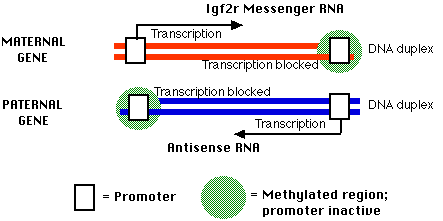Imprinted Genes
Imprinted genes are genes whose expression is determined by the parent that contributed them.
Imprinted genes violate the usual rule of inheritance that both alleles in a heterozygote are equally expressed.
Examples of the usual rule:
- If a child inherits the gene for blood group A from either parent and the gene for group B from the other parent, the child's blood group will be AB.
- If a child inherits the gene encoding hemoglobin A from either parent and the gene encoding hemoglobin S from the other parent, the child's red blood cells will contain roughly equal amounts of the two types of hemoglobin.
But there are a few exceptions to this rule. A small number of genes in mammals (22 of them at the most recent count) have been found to be imprinted. That is, either the maternal (inherited from the mother) or the paternal (inherited from the father) allele is expressed exclusively.
The process usually begins during gamete formation when a certain gene is imprinted in the sperm or in the egg. All the cells in a resulting child will have the same imprinted gene. (Most imprinted genes are repressed.)
Three Examples
1. Igf2
- the gene encoding the insulin-like growth factor 2
In humans (and mice) the Igf2 allele inherited from the father (paternal) is expressed; the allele inherited from the mother is not. If both alleles begin to be expressed in a cell, that cell may develop into a cancer called Wilms´ tumor.
2. Igf2r
- the gene encoding the cell receptor for Igf2
In humans (and mice) the Igf2r allele inherited from the mother is expressed; that from the father is not. Differential imprinting accounts for this and the mechanism is described below.
- the gene encoding the RNA that converts one of the X chromosomes in a female cell into an inactive Barr body. This process is random in the cells of the female fetus and thus is NOT an example of imprinting. However, all the cells of her extraembryonic membranes (which form the amnion, placenta, and umbilical cord) have the father's X chromosome inactivated. Imprinting of the XIST locus accounts for this.
Mechanism of parental imprinting
The process of imprinting start in the gametes where the allele destined to be inactive in the new embryo (either the father's or the mother's as the case may be) is "marked". The mark appears to be methylation of the DNA in the promoter(s) of the gene.

Methyl groups are added to cytosines (Cs) in the DNA. This often occurs at stretches of alternating Cs and Gs called CpG islands.
Methylation of promoters seems to prevent binding of transcription factors to the promoter.
Although methylation seems to be the imprinting signal, keeping the gene shut down may require the production of RNA.
Example 1: the Igf2r gene
A report in Nature (16 October 1997) by Wutz et al, reveals that:
In the mother's (maternal) copy of the gene,
- there is an upstream (left) promoter that is unmethylated and active
- binding of transcription factors to this upstream promoter enables transcription of the sense strand of the gene to produceIgf2r messenger RNA.
- There is also a downstream set of CpG islands that are methylated

In the father's (paternal) copy of the Igf2r gene (the imprinted version)
- the promoter for Igf2r transcription is methylated (and inactive)
- but the downstream promoter is unmethylated and active
- transcription of the antisense strand from the downstream promoter produces an antisense RNA that may participate in shutting his gene down.
Example 2: XIST
The XIST locus on the X chromosome encodes an RNA that shuts down all (or almost all) of the other genes on the chromosome, converting it into an inactive Barr body.
Is imprinting important?
Yes.
-
Deliberate (in mice) or accidental (in humans) inheritance of two copies of a particular chromosome from one parent and none from the other parent is usually fatal (even though a complete genome is present).
- Inheritance of two copies of one of mother's genes and no copy of the father's (or vice versa) can produce serious developmental defects
- failure to inherit the paternal copy of a gene locus on chromosome #15 causes a human congenital disorder called Prader-Willi syndrome
- failure to inherit one maternal copy of the gene locus causes Angelman syndrome.
- failure of imprinting in somatic cells may lead to cancer
- the cancerous cells of a malignancy called Wilms´ tumor have both copies of the Igf2 gene expressed (where only one, the father's, should be)
8 June 1999
